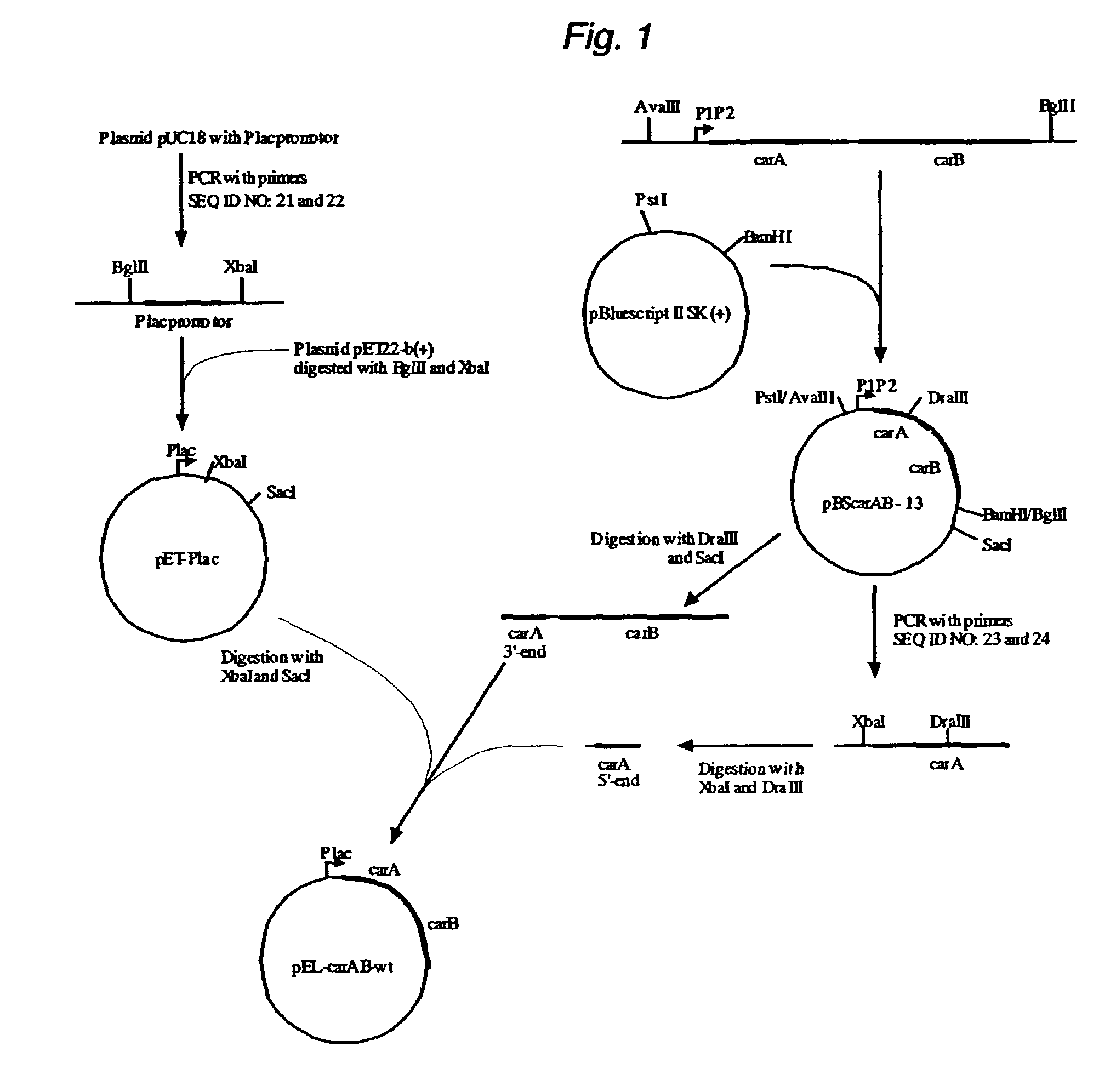Mutant carbamoylphosphate synthetase and method for producing compounds derived from carbamoylphosphate
a technology of carbamoylphosphate and mutant enzyme, which is applied in the field of microorganism industry, can solve the problems of reducing the activity of mutant enzymes in comparison with wild-type enzymes, and achieve the effect of efficient production
- Summary
- Abstract
- Description
- Claims
- Application Information
AI Technical Summary
Benefits of technology
Problems solved by technology
Method used
Image
Examples
example 1
[0057]The plasmid pBScarAB-13 carrying wild type carAB genes from E.coli was constructed by cloning the AvaIII-BglII DNA fragment (4911 bp) from E.coli chromosome to pBluescript II SK(+) vector (Fermentas, Lithuania) previously digested by BamHI and PstI.
[0058]The plasmid pET22-b(+) (Novagen, USA) was modified to substitute the T7 promoter by lac promoter. The lac promoter was obtained by PCR amplification using plasmid pUC18 as a template and the oligonucleotides 5′-accagatctgcgggcagtgagcgcaacgc-3′ (SEQ ID NO: 21) and 5′-gtttctagatcctgtgtgaaattgttatccgc-3′ (SEQ ID NO: 22) as a primers. The resulted fragment (0.14 kb) carrying the lac promoter was digested by restrictases BglII and XbaI and cloned into pET22-b(+) vector previously digested by the same restrictases. The resulted plasmid pET-Plac was used for cloning the carAB genes without promoter from plasmid pBScarAB-13.
[0059]The 5′-end of carA gene (1.18 kb) was obtained by PCR amplification using pBScarAB-13 as a template and ol...
example 2
Isolation of New carB Mutants and Effect of Amino Acid Substitutions in CPSase on Catalytic Properties
[0070]At first, the CarAB activity and its feed back resistance to UMP were evaluated in reactions of biosynthesis of the citrulline from ornithine catalyzed by CarAB and ArgI (ornitine carbamoyltransferase) enzymes in forty recombinant B-6969(pEL-carAB-NN) clones.
[0071]The scheme of reaction is following:
[0072]In this reaction carbamoylphosphate synthetase uses free NH4+ as substrate.
[0073]The protein extracts from forty B-6969(pEL-carAB-NN) strains and TG1(pUC18-argI) cells were prepared from crude cellular extracts of sonicated cells by precipitation with (NH4)2SO4 (75% of saturation). The protein precipitates were solubilized in buffer of following composition: Tris-HCl (50 mM), pH 7.5, 2-mercaptoethanol (2 mM).
[0074]The test-system included the protein extracts from strains B-6969(pEL-carAB-NN) and TG1(pUC18-argI) and following reagents: ATP (8 mM), MgSO4 (8 mM), (NH4)2SO4 (20...
example 3
Production of Orotic Acid Using the Strains Carrying Mutant carAB Genes
[0089]The strain 311 was derived from E.coli K12 having insertion of Tn 10 into the argA gene (VKPM B-3853) as a mutant strain resistant to 6-azauracil (1 mg / ml). The strain 311 has been deposited in the Russian National Collection of Industrial Microorganisms (VKPM) under the accession number: VKPM B-8085, since Mar. 5, 2001, and then the original deposit was converted to the international deposit on Jul. 17, 2002, according to the provisions of Budapest Treaty.
[0090]Strain 311 was transformed with plasmids pMW-carABwt and pMW-carAB-34 and production of orotic acid by resulted recombinant strains in the presence of different concentrations of uridine was tested.
[0091]The cultivation conditions in test-tube fermentation was as follows:
[0092]1 / 20 diluted overnight culture, 60 g / l glucose, 25 g / l ammonia sulfate, 2 g / l KH2PO4, 1 g / l MgSO4, 0.1 mg / l thiamine, 5 g / l yeast extract Difco, 25 g / l chalk, per 1 liter of t...
PUM
| Property | Measurement | Unit |
|---|---|---|
| temperature | aaaaa | aaaaa |
| temperature | aaaaa | aaaaa |
| temperature | aaaaa | aaaaa |
Abstract
Description
Claims
Application Information
 Login to View More
Login to View More - R&D
- Intellectual Property
- Life Sciences
- Materials
- Tech Scout
- Unparalleled Data Quality
- Higher Quality Content
- 60% Fewer Hallucinations
Browse by: Latest US Patents, China's latest patents, Technical Efficacy Thesaurus, Application Domain, Technology Topic, Popular Technical Reports.
© 2025 PatSnap. All rights reserved.Legal|Privacy policy|Modern Slavery Act Transparency Statement|Sitemap|About US| Contact US: help@patsnap.com



